Research Methodology: A Study on Recruitment, Sampling, and Surveys
VerifiedAdded on 2020/10/22
|6
|843
|309
Report
AI Summary
This report details the research methodology employed, focusing on recruitment strategies, population sampling techniques, and survey instruments. The recruitment strategy emphasizes the importance of participant quality and the use of expert contacts for qualitative research. The report then explains the difference between probability and non-probability sampling methods, advocating for random sampling with a sample size of 50 customers in the tourism industry. Finally, it describes the use of survey instruments, specifically questionnaires with close-ended questions, to gather data on opinions and beliefs. The report references several academic sources to support its methodological choices.
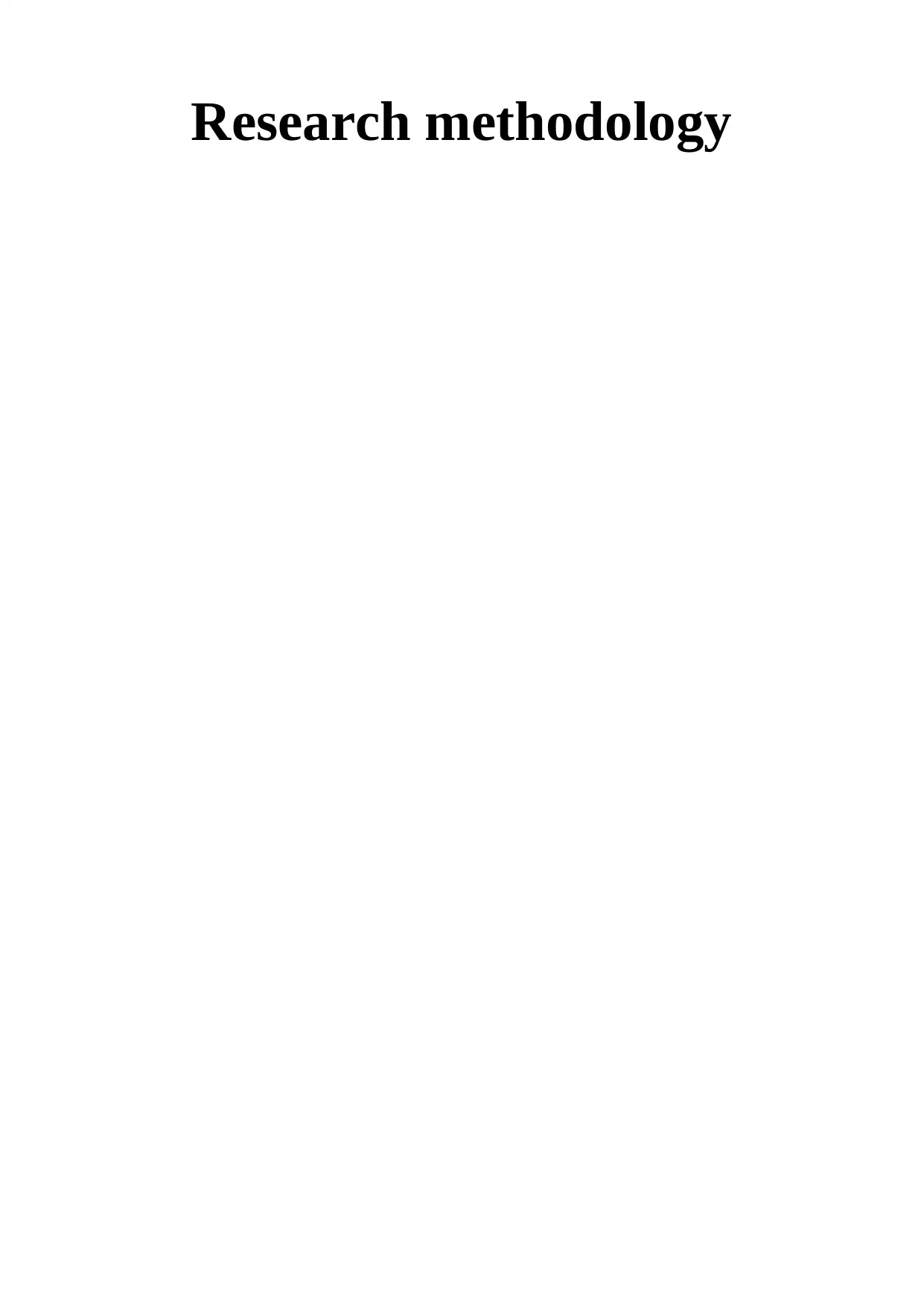
Research methodology
Paraphrase This Document
Need a fresh take? Get an instant paraphrase of this document with our AI Paraphraser
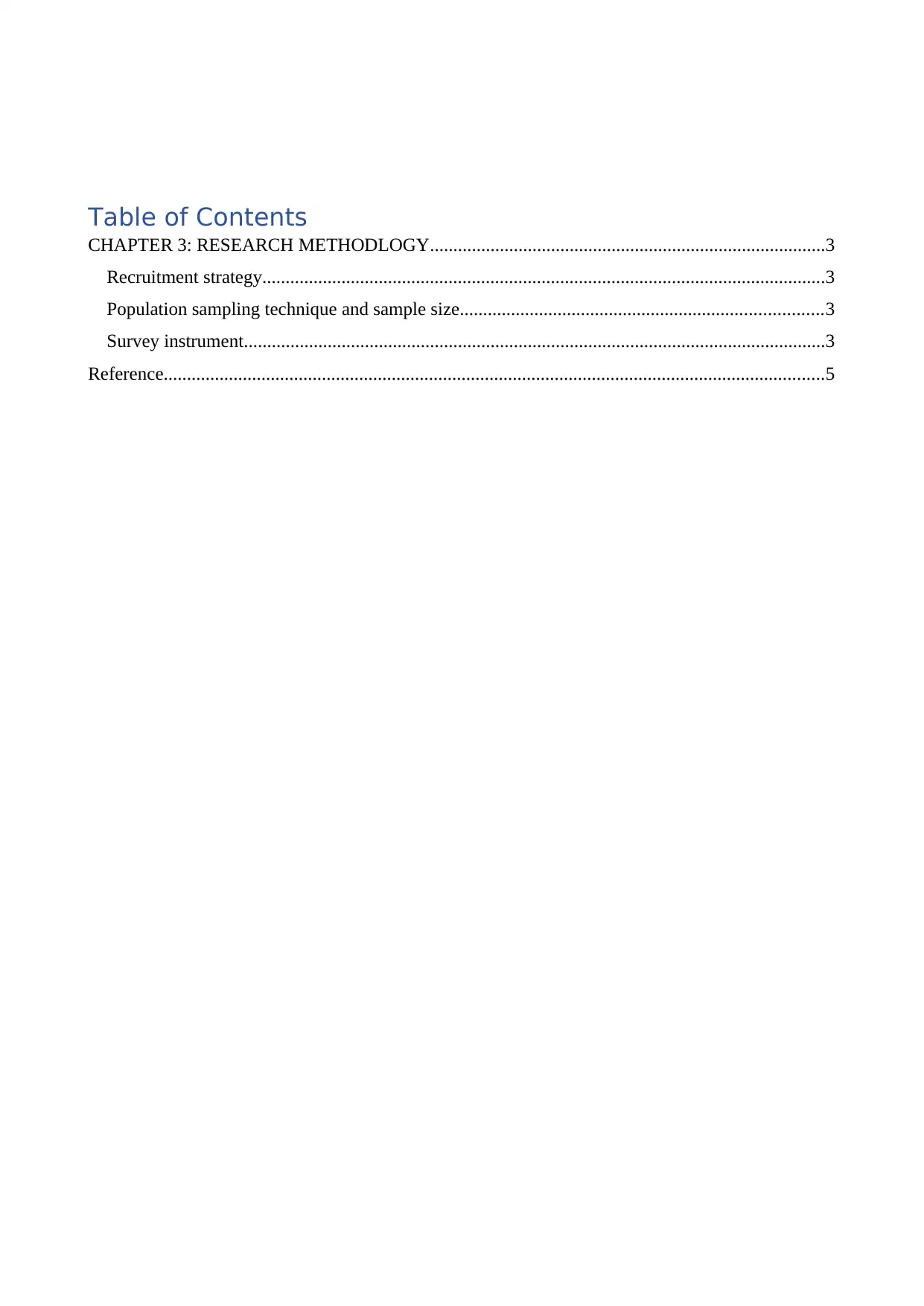
Table of Contents
CHAPTER 3: RESEARCH METHODLOGY.....................................................................................3
Recruitment strategy.........................................................................................................................3
Population sampling technique and sample size..............................................................................3
Survey instrument.............................................................................................................................3
Reference..............................................................................................................................................5
CHAPTER 3: RESEARCH METHODLOGY.....................................................................................3
Recruitment strategy.........................................................................................................................3
Population sampling technique and sample size..............................................................................3
Survey instrument.............................................................................................................................3
Reference..............................................................................................................................................5
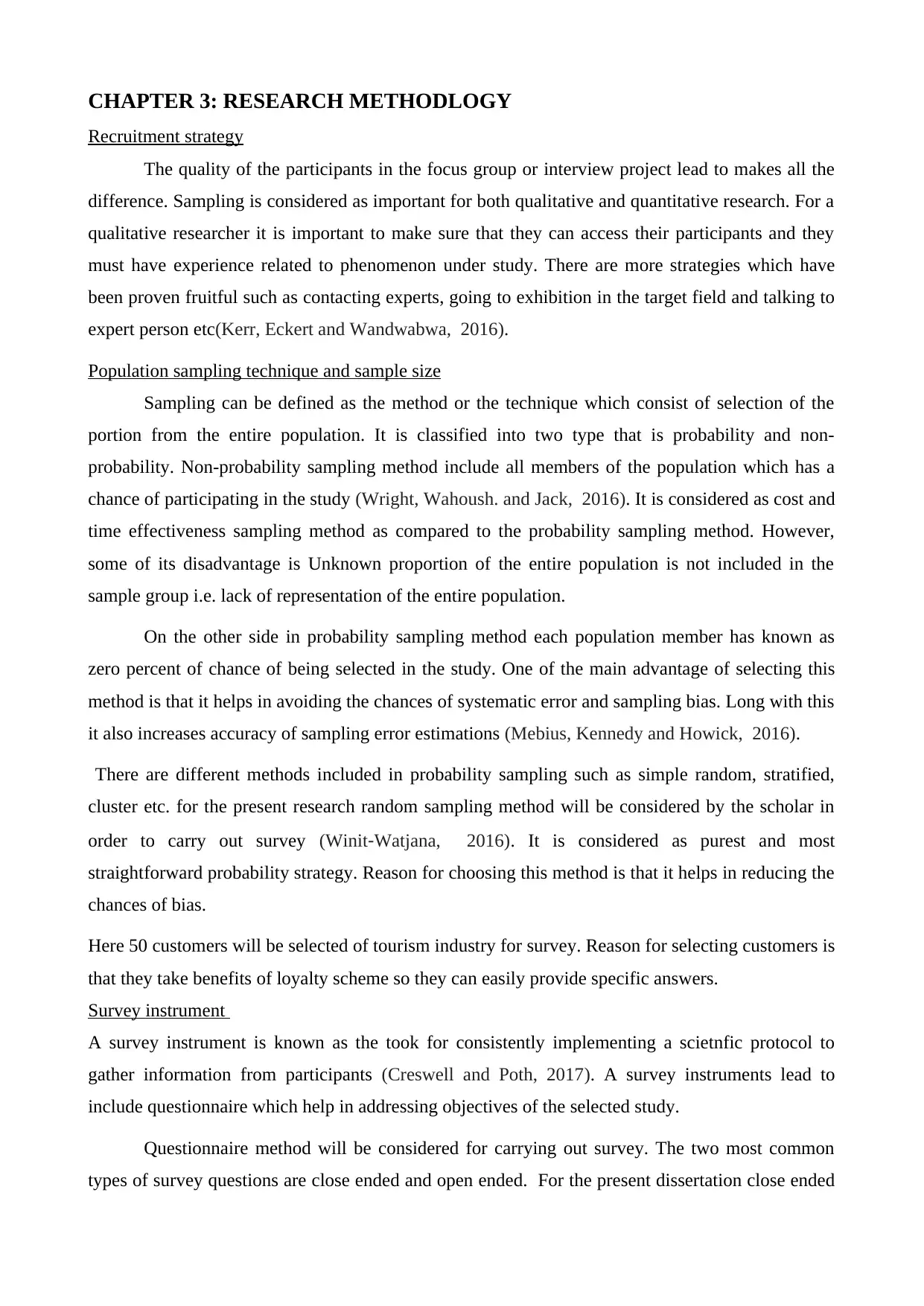
CHAPTER 3: RESEARCH METHODLOGY
Recruitment strategy
The quality of the participants in the focus group or interview project lead to makes all the
difference. Sampling is considered as important for both qualitative and quantitative research. For a
qualitative researcher it is important to make sure that they can access their participants and they
must have experience related to phenomenon under study. There are more strategies which have
been proven fruitful such as contacting experts, going to exhibition in the target field and talking to
expert person etc(Kerr, Eckert and Wandwabwa, 2016).
Population sampling technique and sample size
Sampling can be defined as the method or the technique which consist of selection of the
portion from the entire population. It is classified into two type that is probability and non-
probability. Non-probability sampling method include all members of the population which has a
chance of participating in the study (Wright, Wahoush. and Jack, 2016). It is considered as cost and
time effectiveness sampling method as compared to the probability sampling method. However,
some of its disadvantage is Unknown proportion of the entire population is not included in the
sample group i.e. lack of representation of the entire population.
On the other side in probability sampling method each population member has known as
zero percent of chance of being selected in the study. One of the main advantage of selecting this
method is that it helps in avoiding the chances of systematic error and sampling bias. Long with this
it also increases accuracy of sampling error estimations (Mebius, Kennedy and Howick, 2016).
There are different methods included in probability sampling such as simple random, stratified,
cluster etc. for the present research random sampling method will be considered by the scholar in
order to carry out survey (Winit‐Watjana, 2016). It is considered as purest and most
straightforward probability strategy. Reason for choosing this method is that it helps in reducing the
chances of bias.
Here 50 customers will be selected of tourism industry for survey. Reason for selecting customers is
that they take benefits of loyalty scheme so they can easily provide specific answers.
Survey instrument
A survey instrument is known as the took for consistently implementing a scietnfic protocol to
gather information from participants (Creswell and Poth, 2017). A survey instruments lead to
include questionnaire which help in addressing objectives of the selected study.
Questionnaire method will be considered for carrying out survey. The two most common
types of survey questions are close ended and open ended. For the present dissertation close ended
Recruitment strategy
The quality of the participants in the focus group or interview project lead to makes all the
difference. Sampling is considered as important for both qualitative and quantitative research. For a
qualitative researcher it is important to make sure that they can access their participants and they
must have experience related to phenomenon under study. There are more strategies which have
been proven fruitful such as contacting experts, going to exhibition in the target field and talking to
expert person etc(Kerr, Eckert and Wandwabwa, 2016).
Population sampling technique and sample size
Sampling can be defined as the method or the technique which consist of selection of the
portion from the entire population. It is classified into two type that is probability and non-
probability. Non-probability sampling method include all members of the population which has a
chance of participating in the study (Wright, Wahoush. and Jack, 2016). It is considered as cost and
time effectiveness sampling method as compared to the probability sampling method. However,
some of its disadvantage is Unknown proportion of the entire population is not included in the
sample group i.e. lack of representation of the entire population.
On the other side in probability sampling method each population member has known as
zero percent of chance of being selected in the study. One of the main advantage of selecting this
method is that it helps in avoiding the chances of systematic error and sampling bias. Long with this
it also increases accuracy of sampling error estimations (Mebius, Kennedy and Howick, 2016).
There are different methods included in probability sampling such as simple random, stratified,
cluster etc. for the present research random sampling method will be considered by the scholar in
order to carry out survey (Winit‐Watjana, 2016). It is considered as purest and most
straightforward probability strategy. Reason for choosing this method is that it helps in reducing the
chances of bias.
Here 50 customers will be selected of tourism industry for survey. Reason for selecting customers is
that they take benefits of loyalty scheme so they can easily provide specific answers.
Survey instrument
A survey instrument is known as the took for consistently implementing a scietnfic protocol to
gather information from participants (Creswell and Poth, 2017). A survey instruments lead to
include questionnaire which help in addressing objectives of the selected study.
Questionnaire method will be considered for carrying out survey. The two most common
types of survey questions are close ended and open ended. For the present dissertation close ended
⊘ This is a preview!⊘
Do you want full access?
Subscribe today to unlock all pages.

Trusted by 1+ million students worldwide
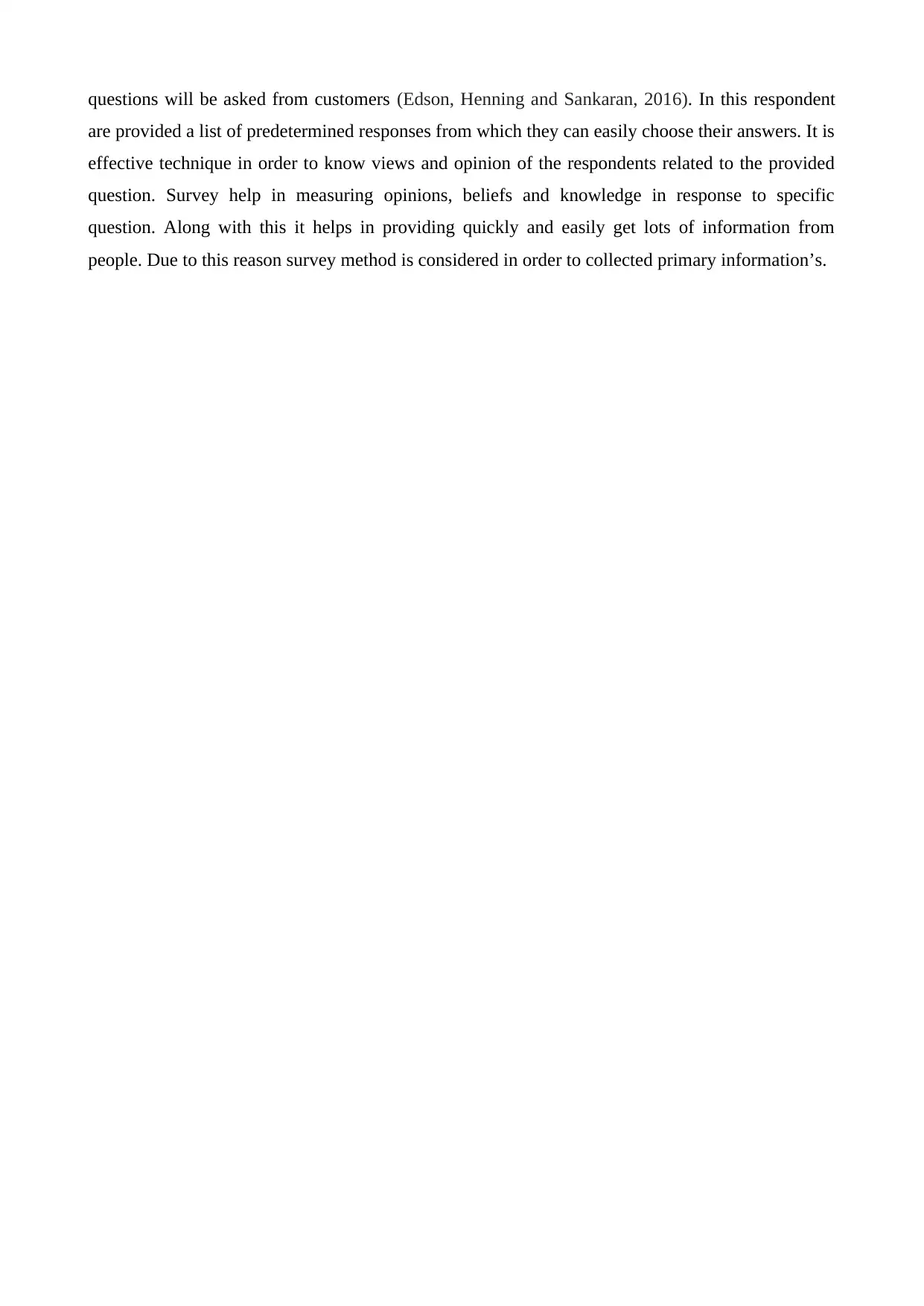
questions will be asked from customers (Edson, Henning and Sankaran, 2016). In this respondent
are provided a list of predetermined responses from which they can easily choose their answers. It is
effective technique in order to know views and opinion of the respondents related to the provided
question. Survey help in measuring opinions, beliefs and knowledge in response to specific
question. Along with this it helps in providing quickly and easily get lots of information from
people. Due to this reason survey method is considered in order to collected primary information’s.
are provided a list of predetermined responses from which they can easily choose their answers. It is
effective technique in order to know views and opinion of the respondents related to the provided
question. Survey help in measuring opinions, beliefs and knowledge in response to specific
question. Along with this it helps in providing quickly and easily get lots of information from
people. Due to this reason survey method is considered in order to collected primary information’s.
Paraphrase This Document
Need a fresh take? Get an instant paraphrase of this document with our AI Paraphraser
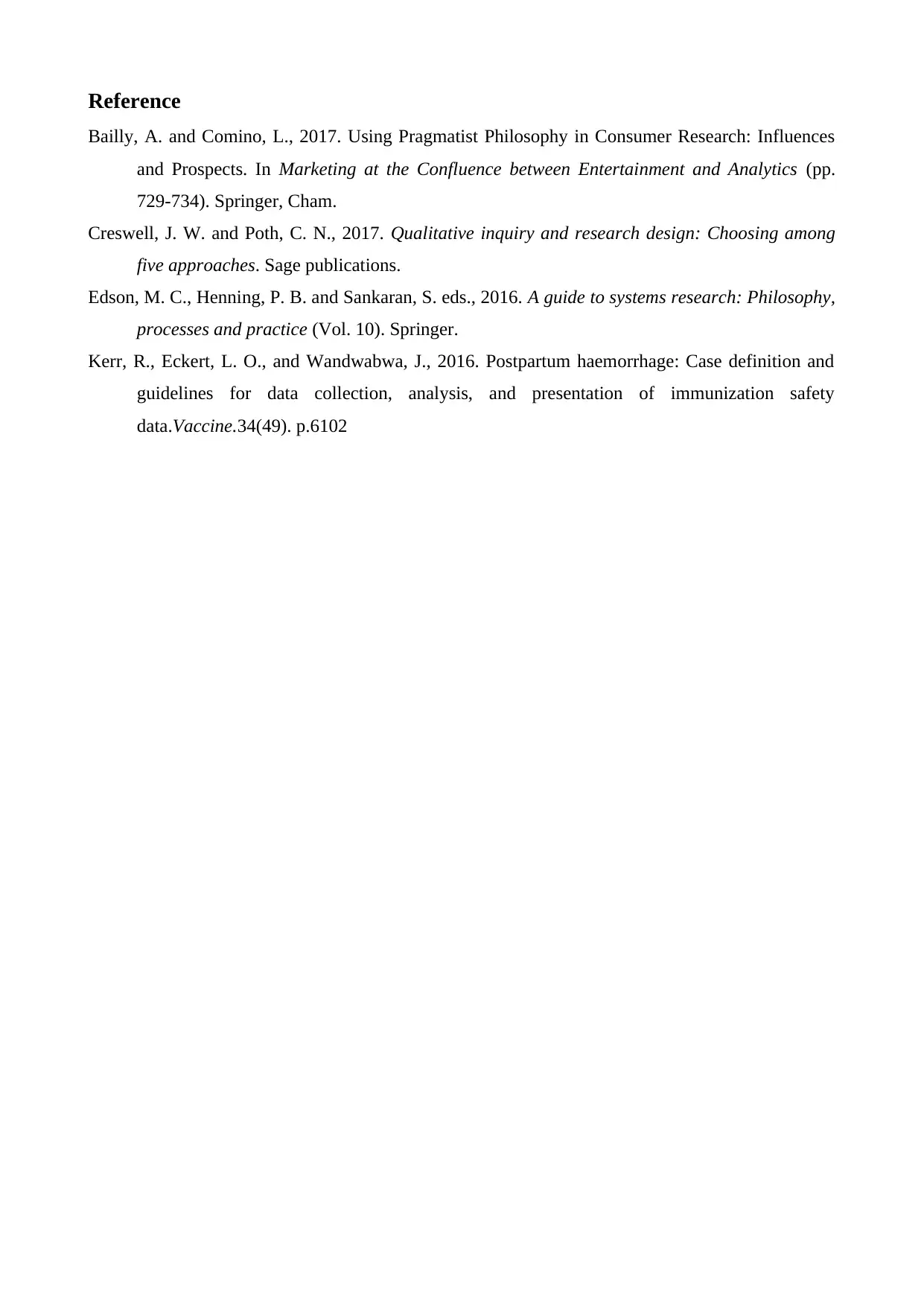
Reference
Bailly, A. and Comino, L., 2017. Using Pragmatist Philosophy in Consumer Research: Influences
and Prospects. In Marketing at the Confluence between Entertainment and Analytics (pp.
729-734). Springer, Cham.
Creswell, J. W. and Poth, C. N., 2017. Qualitative inquiry and research design: Choosing among
five approaches. Sage publications.
Edson, M. C., Henning, P. B. and Sankaran, S. eds., 2016. A guide to systems research: Philosophy,
processes and practice (Vol. 10). Springer.
Kerr, R., Eckert, L. O., and Wandwabwa, J., 2016. Postpartum haemorrhage: Case definition and
guidelines for data collection, analysis, and presentation of immunization safety
data.Vaccine.34(49). p.6102
Bailly, A. and Comino, L., 2017. Using Pragmatist Philosophy in Consumer Research: Influences
and Prospects. In Marketing at the Confluence between Entertainment and Analytics (pp.
729-734). Springer, Cham.
Creswell, J. W. and Poth, C. N., 2017. Qualitative inquiry and research design: Choosing among
five approaches. Sage publications.
Edson, M. C., Henning, P. B. and Sankaran, S. eds., 2016. A guide to systems research: Philosophy,
processes and practice (Vol. 10). Springer.
Kerr, R., Eckert, L. O., and Wandwabwa, J., 2016. Postpartum haemorrhage: Case definition and
guidelines for data collection, analysis, and presentation of immunization safety
data.Vaccine.34(49). p.6102
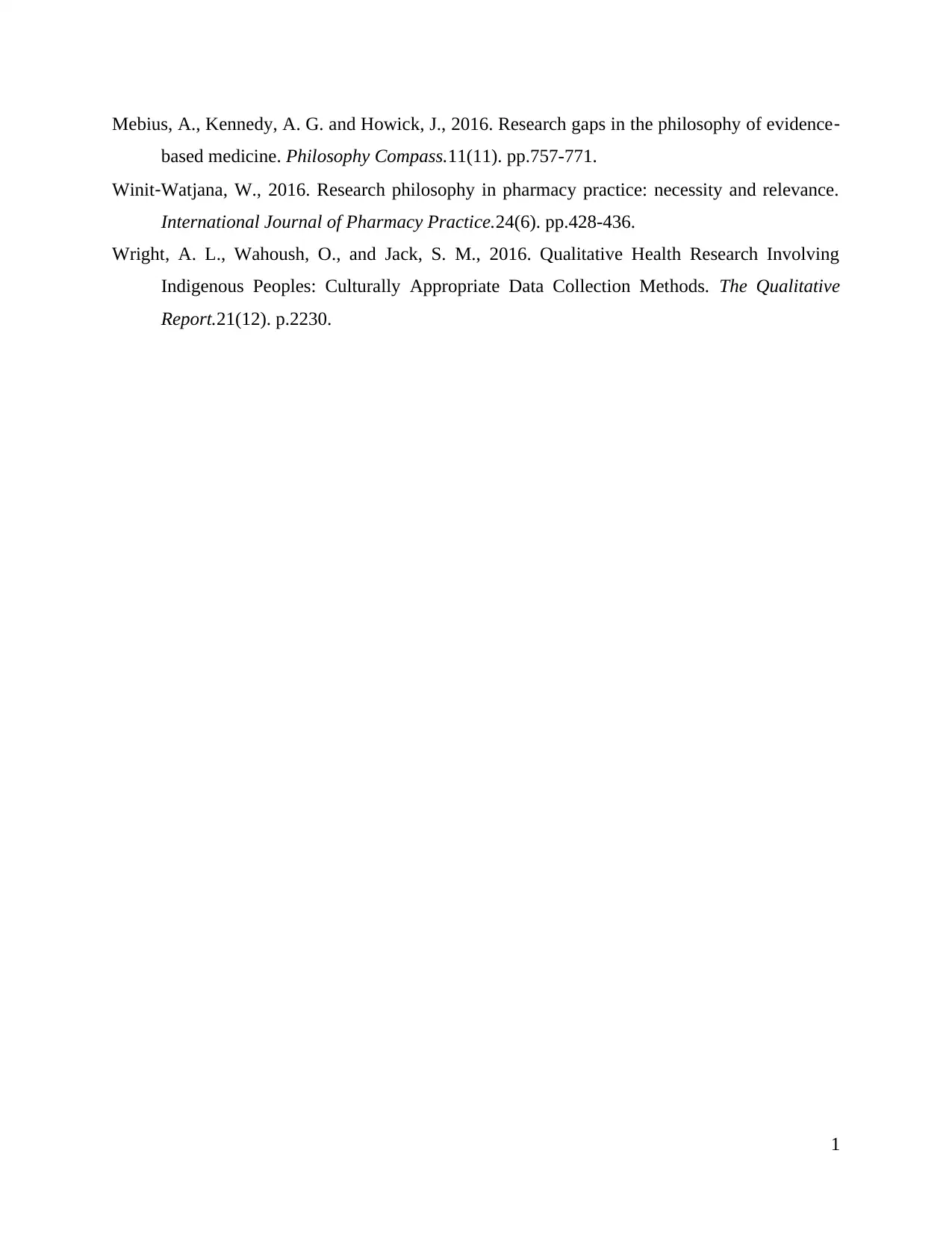
Mebius, A., Kennedy, A. G. and Howick, J., 2016. Research gaps in the philosophy of evidence‐
based medicine. Philosophy Compass.11(11). pp.757-771.
Winit‐Watjana, W., 2016. Research philosophy in pharmacy practice: necessity and relevance.
International Journal of Pharmacy Practice.24(6). pp.428-436.
Wright, A. L., Wahoush, O., and Jack, S. M., 2016. Qualitative Health Research Involving
Indigenous Peoples: Culturally Appropriate Data Collection Methods. The Qualitative
Report.21(12). p.2230.
1
based medicine. Philosophy Compass.11(11). pp.757-771.
Winit‐Watjana, W., 2016. Research philosophy in pharmacy practice: necessity and relevance.
International Journal of Pharmacy Practice.24(6). pp.428-436.
Wright, A. L., Wahoush, O., and Jack, S. M., 2016. Qualitative Health Research Involving
Indigenous Peoples: Culturally Appropriate Data Collection Methods. The Qualitative
Report.21(12). p.2230.
1
⊘ This is a preview!⊘
Do you want full access?
Subscribe today to unlock all pages.

Trusted by 1+ million students worldwide
1 out of 6
Related Documents
Your All-in-One AI-Powered Toolkit for Academic Success.
+13062052269
info@desklib.com
Available 24*7 on WhatsApp / Email
![[object Object]](/_next/static/media/star-bottom.7253800d.svg)
Unlock your academic potential
Copyright © 2020–2025 A2Z Services. All Rights Reserved. Developed and managed by ZUCOL.





